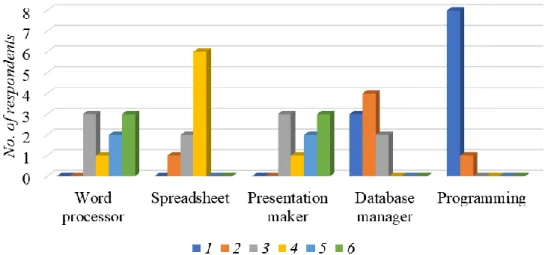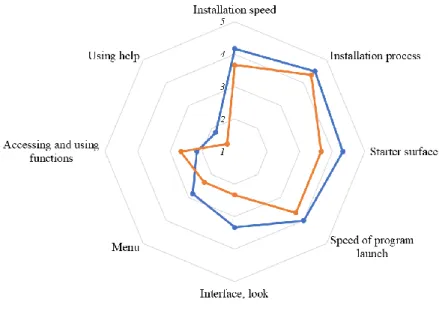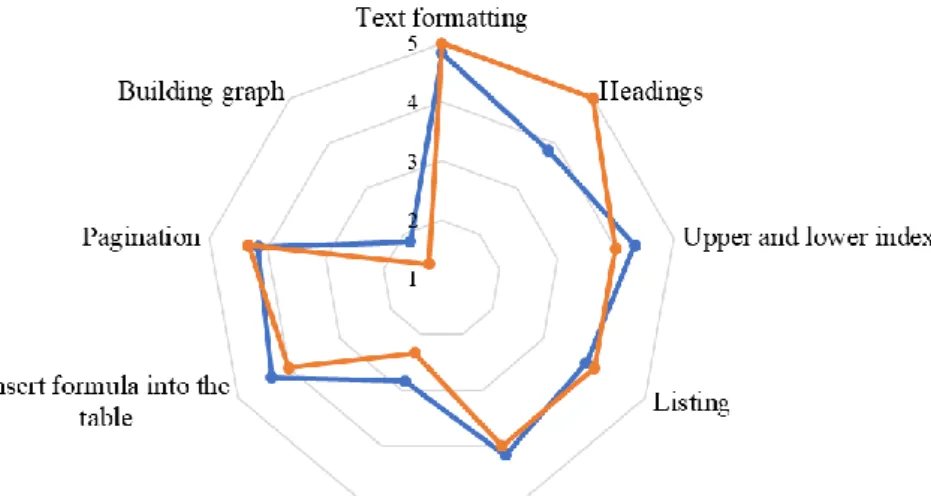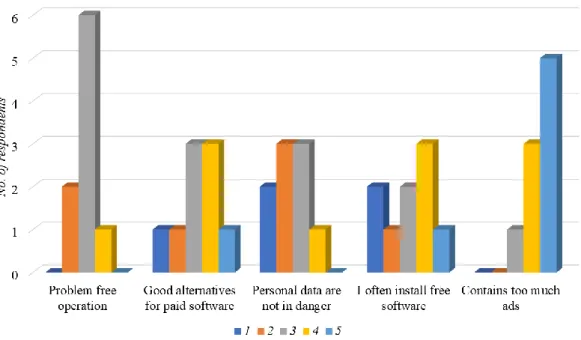LIBREOFFICE IN PUBLIC SERVICE:
FIRST IMPRESSIONS OF THE FUTURE USERS
László Berényi
1and Péter László Sasvári
2DOI: 10.24989/ocg.v335.32
Abstract
There are definite intentions and efforts for spreading open source office software in the Hungarian public service. However, LibreOffice offers almost the same functionality than Microsoft Office, document compatibility may be problematic, and both the appearance and the access to a part of functions are different. Even a partial changeover raises several challenges concerning technical issues, system safety, and users’ education.
This paper investigates the users’ opinions about LibreOffice Writer. The target audience is the higher education students as the future users of the software. The research method includes a (1) preliminary survey about the computer usage habits, (2) preparing a two-page document including typing, text-formatting, tables and diagrams, (3) and a final evaluation survey about the experiences. The goal of the study is collecting information about the opinions and impressions about working with LibreOffice Writer. Exploring the user profiles and the critical issues are important for establishing effective training programs.
Results show that the involved students feel using LibreOffice more difficult than Microsoft Word.
However, the similar surface and functions are available, the deviation from the usual increases the time need and decreases personal satisfaction. Targeted training is necessary for supporting the implementation intentions including developing higher education programs.
1. Introduction
Nowadays, information and communication technologies (ICTs) are key elements of supporting the growth of e-government initiatives [8]. There is a common issue of the participants of public administration actions: information flow. However, several office cases can be managed through a menu structure in an online system, direct communication between the citizens and the public administration service provider is still inevitable. Preparing a document, like appendixes of submissions or applications, CV-s, learning materials etc. is usually managed by a word processor software regardless of the format (electronic or paper-based appearance) of the document.
Microsoft Word can be considered as the etalon of word processors, although, more solutions are available. The question emerges, which word processor software should be used? Interoperability with IT systems and other software ([11], [13]), easy to use user interface, additional services available, problem-free operation ([14], [17]) are equally critical challenges. Software selection requires a comprehensive approach (Figure 1).
1 National University of Public Service, Institute of E-Government, berenyi.laszlo@uni-nke.hu
2 National University of Public Service, Institute of E-Government, sasvari.peter@uni-nke.hu
Figure 1. IT success model with added components of each dimension [15]
There is a competition between the commercial and the (free) open source software ((F)OSS).
Although an indisputable benefit of free software is the cost-free access to the software, a broader approach is required: time need and effort of installing, maintaining the software, learning and teaching the use raise costs. Assuring interoperability with other systems may also need development actions. Rab [13] mentions the case of Bristol where the saving has been achieved 1.4 million euro, however, the costs of the change-over process were twice as much as an upgrade of the former solution.
Beyond cost, there are other considerations [17]:
- Due to the public accountability of governments to all its citizens and the underpinning philosophy of open source software (OSS) is congruent with this approach and changing to these could benefit all.
- OSS has the potential to avoid the monopoly of software providers.
- Reliability and customizability can be enhanced through OSS software.
Beyond the reasons mentioned above, users’ competencies and willingness to use need to be dealt with (see e.g. [5]) as well as users’ satisfaction through perceived benefits [7]. If using a software leads to stress, it may have an unfavorable impact on the work-performance as well. We believe that users’ dissatisfaction can mainly be traced back to misunderstandings and the lack of knowledge.
Developing the intention to use is just as important as practicing.
2. Research design
2.1. Research goal
This research is inspired by the initiation that the Hungarian public administration encourages using LibreOffice. National University of Public Services (NUPS, Budapest, Hungary) aims to adjust the
related courses to this initiation. According to effective and efficient utilization, the question raises whether users are ready and able to use the software. Besides software installation and other technical issues, users’ preparedness cannot be neglected. Both knowledge and motivation are key influencing factors. Assuming that the students will use LibreOffice during the daily work in the future, mutatis mutandis their education has a top priority. Exploring the premises, impressions and the opinions of the (potential) users may help to develop a targeted education program.
The study collects information about the opinions and impressions about working with LibreOffice Writer. Exploring the user profiles and the critical issues are important for establishing effective training programs. According to our assumption that the Microsoft Word is a more popular word processor than LibreOffice Writer and the functions and commands of the former one are decisive, exploring the critical opinions is an essential challenge. Using the experience of the study in curricula development may accelerate the process of change including developing further learning materials and tutorials.
2.2. Research method
LibreOffice has a long history. Its predecessor, the OpenOffice was launched in 2001 and the project became one of the important office software [6]. Despite the long history, we found that most of the higher education students do not have any experience with it.
The research focuses on LibreOffice Writer. The method includes a systematic set of surveys and a task:
- includes a former survey about general ICT issues and related competencies [3],
- includes a preliminary and a follow-up survey measuring the habits and the level of satisfaction, opinions about free software, experiences with Libre Office Writer.
- a 2-page document (available in pdf format) for practicing LibreOffice Writer functions including text formatting, headings, tables, graphs etc.
The task allows collecting experience with the software and established a more valid evaluation of the features and usability.
Moreover, the survey collects additional information including experiences of the software installation process and general opinions about free software. However, additional issues are out of the scope and competencies of word processing tasks but allow a better understanding of the personal opinions and approaches.
2.3. Research sample and limitations
The paper deals with the pilot run of the research. There were 9 bachelor level, full-time students of the Nation University of Public Service involved. Their feedback is important for refining the methodology and running more extensive research among public administration and other students.
The limitations of the interpretation can be traced back to the sample size and its pilot nature. There are no general conclusions allowed based on the results.
5 of the 9 participants are first-year students. According to their own declaration, they can use word processor and presentation maker quite well, spreadsheet moderately and database manager or programming is out of their knowledge (Figure 2 summarizes the results of the total sample).
The participants are critical to their opportunities for computer work. All of them is dissatisfied with the performance of their own computer, rather dissatisfied with the internet speed and the available space for working.
IT education in elementary school is evaluated rather poor, and 5 of them thinks it excellent in higher education. There is no significant correlation between the evaluation results by different levels of education.
Figure 2. Self-declarations about software competencies (1: not at all, 6: I do almost any task in it)
3. Results and discussion
3.1. Software use
The respondents are not well informed about the availability and service of word processors.
Microsoft Word is mentioned as the used one by each respondent and LibreOffice Writer in one case. No other software is mentioned as a known one. It was the first experience with LibreOffice for 6 of 9 students. Although the differences are not significant based on the results of a cross- tabulation analysis, the results show that these students are more satisfied with Writer than ones who have former experiences (Figure 3). However, 4 of them marked definitely not to use the software in the future, 4 of them maybe and only 1 yes.
The participants were asked to download and install LibreOffice to their own computers and review its interface and functions before preparing the task of the research. Figure 3. shows the average satisfaction of the respondents.
Figure 3. Satisfaction with LibreOffice Writer (1: very dissatisfied, 5: very satisfied)
As a part of the final evaluation survey, the participants were asked to compare Writer and Word.
The results obviously show that Word is favored:
- the interface of the Word is preferred to Writer by 6 students (66.7%),
- usability is evaluated alike by 1 student (11.1%), 4 (44.4%) feels Word better and 4 (44.4%) much better.
- available functions are evaluated equally great by 4 (44.4%), while 2 of them (22.2%) feels Word better and 3 of them (33.3%) much better.
3.2 Evaluation of the task
The word processing task required 40-180 minutes to perform. 6 of 9 students finished it within 65 minutes; beyond that 123, 130 and 180 minutes are marked.
The survey lists the dedicated tasks for evaluation including text formatting, managing headings, listing and inserting pictures that were found less challenging by most of the students. Figure 4 highlights the results by the level of experiences. Pagination, tablet formatting, and built-in chart maker were more serious tasks, the patterns by experiences are similar.
Figure 4. Evaluation of tasks (1: very difficult to do, 5: simple to do)
The following can be highlighted based on the discussion of the experiences:
- built-in spreadsheet solutions are liked by the students,
- the participants feel that the LibreOffice Writer is up-to-date and professional,
- access some everyday functions (e.g. set up margins) are less clear than usual (i.e. in Word),
- some functions and options have more complex setting options than expected.
3.3 Opinions about free software
During a job, the word processor can be considered as an enabler, employees usually do not have any influence on software selection or the installation process. Despite this fact, we consider it important to collect additional information. Opinions about free software as well as the experiences of the installation process give important background information. The participants of the pilot survey have diverse opinions about free software (Figure 5). They are the most critical of personal data protection. Furthermore, the analysis of correlation (2-tailed Pearson-correlation) shows that problem-free operation positively correlates with the statement that these are reasonable alternatives to paid software (P.corr=.731, sig=.025) and the safety of personal data (P.corr=.693, sig=.038).
Correlation between being an alternative for paid software regular use of free software is remarkable (P.corr=.809, sig=.008).
Figure 5. Evaluation of free software (1: I do not agree at all, 5: I fully agree)
The results are encouraging in the sense that students do no reject free software solutions and keep them rather reasonable alternatives. The business model that leads to the problem of ads is known but out of the scope of the present study. Worry about personal data clearly confirms the development of consciousness about cyber safety.
4. Conclusions
4.1. Experiences of the research
Solving the word processing task did not give an impossible challenge to any of the participants, the main experience of the research is that LibreOffice is less known among the selected higher education students. However, functional competencies were available mainly learned with Microsoft Office Word, and the task was done within an acceptable time period, using software out of the comfort zone led to stress and dissatisfaction. Results of first-time users show a higher level of satisfaction about LibreOffice Writer than in the case of ones with former experiences. Word is remarkably preferred in most functions to Writer among the respondents.
It is to note, that openness to free software is encouraging. However, it raises programming issues, from a cyber security viewpoint it confirms the international and national aspirations to improving cyber consciousness, including the effort of our research community [1], [4], [9], [10], [16].
LibreOffice Writer seems to be suitable for most text-editing and formatting tasks of everyday life.
We believe that targeted information and support, especially positive communication may increase trust in using it.
According to the product lifecycle mode [2], OpenOffice/LibreOffice has a long take-off period while Word is on the top. Based on its features it should be a mature product or serve as a substitute software of Microsoft Office, “commercialization” is still missing. Our research shows that the actual penetration of Microsoft Office allows limited possibilities to others including online
solutions as well (e.g. Google Docs), in consequence, the changeover process may be slow and quite uncertain.
4.2. Further challenges
Based on the observations of the pilot survey we concluded that task that asks for preparing a document is an effective part of the research as well as pre- and after task surveys must be kept, but the content of the surveys can be refined. Extending the survey is necessary for establishing statistically relevant results in the field.
Furthermore, the experiences of the research clearly point out the accelerating the education of LibreOffice may lead to increased confidence through the knowledge to use the software. This includes developing targeted learning materials. Considering the governmental intentions for the presence of a higher proportion of (F)OSS software in public administration, this challenge has a high priority and requires a systematic approach [12].
5. References
[1] BÁNYÁSZ, P., The Emergence of Cyber Security in The Scientific Community. Hadmérnök.
13, 3 (2018), p. 362–377.
[2] BASS, F. M., A new product growth model for consumer durables. Management Science. 15, 1 (1969), p. 215–227.
[3] BERÉNYI, L., Changing Trends in ICT Use - A Generation Y Analysis. Theory Methodology Practice: Club of Economics in Miskolc. 13, 1 (2017), p. 9–16.
[4] DÜLL, A., SCHOCH, A., STRAUB, M., Cybersecurity in the European Union. In: Hansen, H., Müller-Török, R., Nemeslaki, A., Prosser, A., Scola, D., Szádeczky, T. (eds.) Central and Eastern European e|Dem˛and e|Gov Days 2018: Conference proceedings. Facultas Verlags- und Buchhandels AG, 2018, Wien, Austria, p. 313–323.
[5] GALLEO, M. D., BUENO, S., RACERO F. J., NOYES, J., Open source software: The effects of training on acceptance. Computers in Human Behavior. 49 (2015), p. 390–399.
[6] GAMALIELSSON, J., LINDELL, B., Long-Term Sustainability of Open Source Software Communities beyond a Fork: A Case Study of LibreOffice. In: Hammounda, I., Lundell, B., Mikkonen, T., Scacchi, W. (eds.), Open Source Systems: Long-Term Sustainability. OSS 2012. IFIP Advances in Information and Communication Technology, 2012, Berlin, Springer, p. 29–47.
[7] GWEBU, K. L., WANG, J., Adoption of Open Source Software: The role of social identification. Decision Support Systems. 51 (2011), p. 220–229.
[8] JOSEPH, R. C., KITLAN, D. P., Key Issues in E-Government and Public Administration. In:
GARSON, G. D., KHOSROW-POUR, M., Handbook of Research on Public Information Technology, 2008, Hershey, IGI Global, p. 1–11.
[9] KOVÁCS, L., NEMESLAKI, A., ORBÓK, Á., SZABÓ, A., Structuration Theory and Strategic Alignment in Information Security Management: a Comprehensive Research Approach and Program. Academic and Applied Research in Military and Public Management Science. 16, 1 (2017), p. 5–16.
[10] KRASZNAY, CS., A kiberbiztonság stratégiai vetületeinek oktatási kérdései a közszolgálatban. Nemzet és Biztonság: Biztonságpolitikai Szemle. 10, 3 (2017), p. 38–53.
[11] LÁSZLÓ, G., A közigazgatásban használt szoftverek komplex hatásai. Információs társadalom. 7, 2 (2007), p. 93–106.
[12] ORBÁN, A., A közigazgatási informatika oktatásának egyes aspektusai. Pro Publico Bono:
Magyar Közigazgatás. 3 (2013), p. 111–120.
[13] RAB, Á., Nyílt forráskódú szoftverek a gazdaságban és az e-kormányzatban. Információs Társadalom. 8, 3 (2008), p. 157–162.
[14] ROSSI, B., RUSSO, B., SUCCI, G., Adoption of free/libre open source software in public organizations: factors of impact. Information Technology & People. 25, 2 (2012), p. 156–187.
[15] SARRAB, M., HUSSAIN REHMAN, O. M., Empirical study of open source software selection for adoption, based on software quality characteristics. Advances in Engineering Software. 69 (2014), p. 1–11.
[16] SZÁDECZKY, T., Cybersecurity Authorities and Related Policies in the EU and Hungary. In:
Hansen, H., Müller-Török, R., Nemeslaki, A., Prosser, A., Scola, D., Szádeczky, T. (eds.) Central and Eastern European e|Dem˛and e|Gov Days 2018: Conference proceedings.
Facultas Verlags- und Buchhandels AG, 2018, Wien, Austria, p. 287–300.
[17] WARING, T., MADDOCKS, P., Open Source Software implementation in the UK public sector: Evidence from the field and implications for the future. International Journal of Information Management. 25 (2005). P. 411–428.
![Figure 1. IT success model with added components of each dimension [15]](https://thumb-eu.123doks.com/thumbv2/9dokorg/911961.51150/2.892.255.640.132.459/figure-success-model-added-components-dimension.webp)



